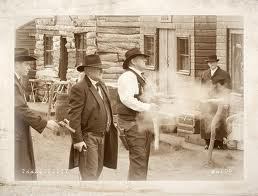Jacqui Murray's Blog, page 157
December 12, 2013
Book Review: Tongwan City
by Gao Jianqun
My rating: 5 of 5 stars
Gao Jianqun’s fascinating novel, Tongwan City (CN Times Books 2013) is the story of the end of the Hun era. It is written as a novel, but feels so close to reality it could rightly be called creative non-fiction. I know nothing about that era–Attila the Hun is the extent–so I had to do some research to determine if this was more fiction than reality or vice-verse. In fact, what little information is readily available supports Jianqun’s recounting. What he does well is fill in the blanks lost to history.
This is the story of two seminal individuals in Chinese history–Helian Bobo who re-establishes Hun supremacy over Asia only to lose it, and the Buddhist monk Kumarajiva who spreads Buddhism throughout the land. Jianqun’s simple summation of the two–one good one evil–doesn’t begin to describe their affect on events that swirl around them. Knowing them now as I do, I wonder how any single era could provide temporal space to two such opposite life forces: One renowned for violence and brutality, the other for peace and tranquility, a powerful juxtaposition of their purpose on earth. Still they cross paths only once, and that time in passing. No wonder it takes half the book before we truly meet both men.
Jianqun’s writer’s voice, as befits a story of this magnitude, is unique. I felt the world of Ancient China seeping into my being with each page turn until finally, I was drenched–and I got it. This is a deeply complicated culture, far different from today’s worlds. Jianqun accomplishes this assault on my cerebral senses with techniques I rarely read in fiction. He includes lots of–really, much more than I’ve ever read in any other fiction book–authorial intrusion where he jumps into the story to discuss research on the history of the times and gives us a peak into what is going to happen later. Truly, I couldn’t tell how much of this was real or his imagination. Oddly, I didn’t find it distracting, more like his personal storytelling style.
Besides history and rich characters, the book has some great horse scenes (the Huns loved their horses):
“When [the horse] ran, its mane ran down its long elegant neck like a fair lady’s hair. A lock reached over its forehead and hung there like bangs… Its four muscular legs, each a finely-tuned symphony of muscle packing massive energy, generated a grand impetus that propelled the strong body to move ahead.”
One note: This is a stunningly noble story which at times seems poorly served by the translation from Jianqun’s native Chinese to English:
“Out of respect for the new life, let us apply some restraint and get the story rolling.”
Overall, though, for historic fiction fans, this is a must-read. Just open it knowing it will read like no other book you’ve ever read–and be ready for a surprise ending.
Jacqui Murray is the author of the popular Building a Midshipman , the story of her daughter’s journey from high school to United States Naval Academy. She is webmaster for six blogs, an Amazon Vine Voice book reviewer, a columnist for Examiner.com and TeachHUB, Editorial Review Board member for Journal for Computing Teachers, a freelance journalist on tech ed topics, and a monthly contributor to Today’s Author. In her free time, she is editor of a K-8 technology curriculum and technology training books for how to integrate technology in education. Currently, she’s editing a thriller that should be out to publishers next summer. Contact Jacqui at her writing office or her tech lab, Ask a Tech Teacher.
Filed under: book reviews Tagged: china, historic fiction, huns


December 10, 2013
113 Ways to Characterize Your Protagonist
 There are a lot of words that describe you and I at different times during the day. Our job as writers is to notice what those moods and attitudes are and put a word to them so readers will feel them. ‘Sad’ doesn’t have enough depth, but ‘bitter’, ‘stricken’, ‘grieved’, and heartsick’ all tell us more about the way the character is handling ‘sad’. They are much more compelling to the reader, likely to draw us in and make us like the character (which keeps us reading).
There are a lot of words that describe you and I at different times during the day. Our job as writers is to notice what those moods and attitudes are and put a word to them so readers will feel them. ‘Sad’ doesn’t have enough depth, but ‘bitter’, ‘stricken’, ‘grieved’, and heartsick’ all tell us more about the way the character is handling ‘sad’. They are much more compelling to the reader, likely to draw us in and make us like the character (which keeps us reading).
Here are more words with color you might like:
absent-minded
active
affable
ambitious
amiable
animated
annoyed
argumentative
arrogant
attentive
bossy
candid
capable
care-free
careful
caustic
cautious
charismatic
charming
clever
cold-hearted
compassionate
complacent
conceited
concerned confused
confident
considerate
cooperative
crafty
cruel
cultured
curious
finicky
frank
fussy
generous
intelligent
determined
eager
easygoing
effervescent
efficient
embarrassed
excited
exuberant
facetious
fair
fanciful
fidgety
fighter
grumpy loquacious
gentle intrepid
hard-working
harried
hardy
harsh
humorous
ill-bred
immature
impartial
impolite
impudent
impulsive
independent
industrious
inimitable
inventive
insipid
insistent
lackadaisical
leader
lovable
loyal reckless
relaxed
resourceful
restless
insolent
decisive
babyish
dependable
bewildered
determined
giddy
jealous
blasé
diligent
giving
jovial
boorish
discouraged
naive
hospitable
negligent
lucky
daring
demanding
doubtful
dutiful
malicious
mature
bossy
dishonest
glum
languid
disparaging
greedy
lively
busy
disrespectful
gregarious
logical
dissatisfied
grouchy

Jacqui Murray is the author of the popular Building a Midshipman , the story of her daughter’s journey from high school to United States Naval Academy. She is webmaster for six blogs, an Amazon Vine Voice book reviewer, a columnist for Examiner.com and TeachHUB, Editorial Review Board member for Journal for Computing Teachers, a freelance journalist on tech ed topics, and a monthly contributor to Today’s Author. In her free time, she is editor of a K-8 technology curriculum and technology training books for how to integrate technology in education. Currently, she’s editing a thriller that should be out to publishers next summer. Contact Jacqui at her writing office or her tech lab, Ask a Tech Teacher.
Filed under: authors, characters, descriptors, writers resources Tagged: characteristics, characters, decriptions, descriptors


December 8, 2013
Writers Tip #62: It’s Not What Happens to Your Character Readers Care About. It’s Their Reaction That Matters
 When you read your story, does it sound off, maybe you can’t quite put your finger on it, but you know you’ve done something wrong? Sometimes–maybe even lots of times–there are simple fixes. These writer’s tips will come at you once a week, giving you plenty of time to go through your story and make the adjustments.
When you read your story, does it sound off, maybe you can’t quite put your finger on it, but you know you’ve done something wrong? Sometimes–maybe even lots of times–there are simple fixes. These writer’s tips will come at you once a week, giving you plenty of time to go through your story and make the adjustments.
Today’s tip: Worry less about plot and more about character development.
If writers had to depend upon plot to sell a story, we’d all go broke. There is one basic plot. Hero starts out with a tolerable/happy/exciting life. Something happens that throws her/him into crisis. S/he tries to solve it (over and over) and fails each time. When s/he is about to fail for the final time, Eureka! Against all odds, Hero pulls it out and is changed forever from the experience.
Here’s a secret: The story line isn’t what matters; it’s how the Hero reacts to events that makes a blockbuster novel. This is where writers can explore a multitude of plotting options. Does the Hero problem solve with his heart or head? Does s/he do it alone or with help? As a lawyer, doctor, archeologist, teacher, some other unique career? That where the story comes in. As individual each person in the world is, that’s how many variations on a theme there are. What you came up with from the short plot I outlined is likely considerably different from my paleo-historic plot line.
So revel in that. Let your voice be heard. Spin your yarn with abandon. The more unique is your imagination, the more spirited your muse, the more likely you will succeed.
More tips on characters:
Words Lie, Body Language Doesn’t
Click to have Writer’s Tips delivered to your email box
Questions you want answered? Leave a comment and I’ll answer it within the next thirty days.

Jacqui Murray is the author of the popular Building a Midshipman , the story of her daughter’s journey from high school to United States Naval Academy. She is webmaster for six blogs, an Amazon Vine Voice book reviewer, a columnist for Examiner.com and TeachHUB, Editorial Review Board member for Journal for Computing Teachers, a freelance journalist on tech ed topics, and a monthly contributor to Today’s Author. In her free time, she is editor of a K-8 technology curriculum and technology training books for how to integrate technology in education. Currently, she’s editing a thriller that should be out to publishers next summer. Contact Jacqui at her writing office or her tech lab, Ask a Tech Teacher.
Filed under: characters, plot, writers tips Tagged: characters, plot, writing tips


December 5, 2013
Book Review: Runner
 Runner
Runner
by Patrick Lee
My rating: 5 of 5 stars
Patrick Lee’s thriller, Runner (Minotaur Books 2014) lives up to its title. From page 1, when Sam Dryden–former Special Forces (and then some), trying and failing to recover from the death of his wife and child–starts running, he never stops. And with him, the action (enough to give you whiplash–in the words of Jesse Kellerman). Every time you think you know what’s going on, you don’t. The settings are well-drawn, characters believable, and the plot complex enough for a Mobius strip.
In a nutshell: Sam Dryden (hero of Patrick Lee’s Sam Dryden series) can’t sleep–a normal condition since he lost his entire family in a car crash. He goes for a 3am run, slams into fleeing 12-year-old Rachel, and agrees to help her escape the band of men chasing her. The fact that she is genetically engineered to be more than human endears her to him rather than frightens him (no surprise, he’s a tough guy). And the race begins–across wide-open spaces, aided by satellite surveillance, a constant battle of muscle vs. mind–lots of men with vicious weapons vs. the cerebral skills of a damaged SF guy and a brilliant young girl who has lost her memory.
I love stories when brawn is matched well by brainy brilliance. Although Sam Dryden is a superman in his own right, the real star of this book is Rachel–genetically engineered to be able to exert mind control over others in very sophisticated ways. The scientific explanation is credible enough to make me want to read more.
Patrick Lee not only is a good story teller, he’s a good writer. I’m always impressed by original similes, and Lee has several that caught my attention:
town sliding past like a tanker in the fog
something flickered through Marsh’s expression… He looked like a chess player assessing some new arrangement of pieces…
One trait I DON’T like in a book is when a publisher compares their writer’s character to the incomparable Jack Reacher. That’s like a contestant on the Voice singing a Barbara Streisand song–you’ll never be that good so why bring up that level of accomplishment?
Overall, a great read. I would have finished the entire book in one day, but time just ran out. I tried.

Jacqui Murray is the author of the popular Building a Midshipman , the story of her daughter’s journey from high school to United States Naval Academy. She is webmaster for six blogs, an Amazon Vine Voice book reviewer, a columnist for Examiner.com and TeachHUB, Editorial Review Board member for Journal for Computing Teachers, Cisco guest blog, and a monthly contributor to Today’s Author. In her free time, she is editor of a K-8 technology curriculum and technology training books for how to integrate technology in education. Currently, she’s editing a thriller that should be out to publishers next summer. Contact Jacqui at her writing office or her tech lab, Ask a Tech Teacher.
Filed under: book reviews Tagged: book review, reacher


December 3, 2013
Fear of Saying Dumb Things Scares Me to Death
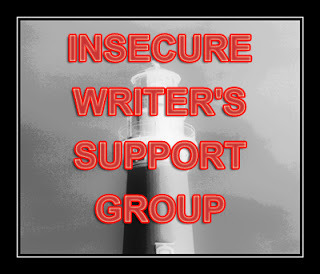 This post is for Alex Cavanaugh’s Insecure Writers Support Group (click the link for details on what that means and how to join. You will also find a list of bloggers signed up to the challenge that are worth checking out). Once a month we all post our thoughts, fears or words of encouragement for fellow writers.
This post is for Alex Cavanaugh’s Insecure Writers Support Group (click the link for details on what that means and how to join. You will also find a list of bloggers signed up to the challenge that are worth checking out). Once a month we all post our thoughts, fears or words of encouragement for fellow writers.
This month’s insecurity: Fear of saying dumb things scares me to death
People who don’t know you–and me–judge us by what we say. They have no historic track record to weigh our comments, ideas, thoughts against. When they meet our words posted online–or blurted out in person–all they know of us is by those words.
So when I say something dumb, it really bothers me. Let’s define ‘dumb’ as–
stupid, as in uneducated, like a fifth-grade understanding of the world when I’m [supposed to be] an adult
not representative of my real thoughts
requires more information than has been communicated to truly get meaning.
meant to be funny but falls flat (I’ve heard the shortest distance between two people is a good laugh or a smooth trigger pull. Both are fraught with danger.)
Sure, it’s harmless if that ‘something’ is ‘oh, Jacqui must like skydiving’. I won’t stay awake at night worrying about that. But if it’s ‘Jacqui hates ***’, yeah, then I might.
I do this more than I like to admit. I pop out with an idea that sounds brilliant in the safety of my hind brain, but as it rolls off my tongue, I realize if it was any dumber it would have to be watered daily. You know the type. Age has tempered the number of times it happens, but not eradicated their occurrence. Back-pedaling when I see surprise or confusion around me helps, but doesn’t fix.
This is why I like the written word better. True, my thoughts are there for posterity, but I can edit, review, rethink, before pushing send. That helps.
How about you?
____________________________________________________________________________________________
Jacqui Murray is the author of the popular Building a Midshipman , the story of her daughter’s journey from high school to United States Naval Academy. She is webmaster for six blogs, an Amazon Vine Voice book reviewer, a columnist for Examiner.com and TeachHUB, Editorial Review Board member for Journal for Computing Teachers, Cisco guest blog, IMS tech expert, and a monthly contributor to Today’s Author. In her free time, s he is the editor of a K-8 technology curriculum, K-8 keyboard curriculum, K-8 Digital Citizenship curriculum, and creator of technology training books for how to integrate technology in education. Currently, she’s editing a thriller that should be out to publishers next summer.
Filed under: communication, writers resources, writing Tagged: communication, iwsg, writers


November 21, 2013
Happy Thanksgiving Week
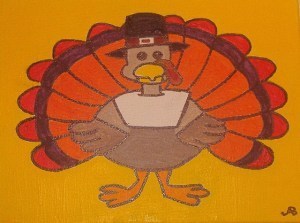 I’m taking next week off. I’ll be preparing for my daughter’s holiday visit from her new home in DC. I am so excited!
I’m taking next week off. I’ll be preparing for my daughter’s holiday visit from her new home in DC. I am so excited!
I’ll be back December 2nd. Any emergencies–drop me a line at askatechteacher@gmail.com.
Jacqui Murray is the author of the popular Building a Midshipman , the story of her daughter’s journey from high school to United States Naval Academy. She is webmaster for six blogs, an Amazon Vine Voice book reviewer, a columnist for Examiner.com and TeachHUB, Editorial Review Board member for Journal for Computing Teachers, Cisco guest blog, and a monthly contributor to Today’s Author. In her free time, she is editor of a K-8 technology curriculum and technology training books for how to integrate technology in education. Currently, she’s editing a thriller that should be out to publishers next summer. Contact Jacqui at her writing office or her tech lab, Ask a Tech Teacher.
Filed under: blogs Tagged: road trip, thanksgiving


November 19, 2013
A Writer’s (Holi)day
 Any writer who has come of age in today’s writing environment knows authors do a lot more than write books. We have three big jobs:
Any writer who has come of age in today’s writing environment knows authors do a lot more than write books. We have three big jobs:
writing–this includes our WIP, blog posts, articles, anything that gets our name out there as a writer and lets us practice our art. On a good day, this might be 60% of what I do.
publishing–includes managing media outlets, getting our work and name out there, finding an agent. This varies from 5% to 80% of a day’s activities.
marketing–finding people who are interested in our writing. Like publishing, this varies depending upon where I am in the writing cycle.
This is most often aside from the Real Job we-all hold to pay the bills, support families, keep us in Starbucks.
With the holidays approaching, I created a TODO list to help me stay organized:
finish the tech thriller I’ve been working on forever.
stay on top of trends in my technology-in-education field. That includes Common Core (a firestorm sweeping the education landscape–yikes!), differentiation, one-on-one education, online education–I could go on. Just reading about this stuff, much less integrating it into my knowledge base, has become daunting. But it’s the cape I wear. Sigh.
answer daily inquiries–this includes requests for help and advice, doing interviews and radio shows, reviewing materials. These are interesting, often unexpected. And always time consuming. Deciding whether I’m a good fit for someone takes a lot of research on my part. I don’t want to promise something I can’t deliver, or disappoint them when I do. It’s all avoidable if I spend upfront time.
market books I’ve published. My marketing is the free sort and includes:
my publisher’s website
other book outlets
blogs
wikis
social networks
word-of-mouth
I subscribe to the ‘five a day’ approach to marketing–seeking out five new people who I haven’t met each day. Sometimes, all that means is 5 tweets. Other days, it’s more involved.
So, I set up a holiday schedule that I hope will accomplish those goals while satisfying the three jobs writer’s do. Three jobs–three parts to the day. Sounds simple. Of course, it only applies when I have full free days:
Morning:
post to my blogs
write book reviews–I like reading reviews of books I might buy, and it turns out, so do my readers.
keep in touch with my social network of writers, friends, colleagues
prepare and tape webinars, online classes
let creativity flower–see what my brain is working on. That’s quite often something else entirely than my plans.
Afternoon:
work on my WIP–currently, a series of books on Common Core in the classroom (sound boring? You’re not a teacher!)
if I need a creativity break, read other people’s writing. I find lots of inspiration in that
Evening:
respond to requests to guest blog, emails–that sort of thing
update my website (must do that weekly or Google will stop finding me)
market my current books on my current outlets
fulfill freelance writing gigs. These are fun and get me thinking outside my box. I always spend too long on these.
read in my genre–thrillers and technology-in-education
I’ve done this before–scheduled stuff–and it didn’t go so well. Morning jobs leaked into afternoon big time. It takes a long time to write blog posts because I get into them. I get distracted by the fun-ness of it. The social networks are a black hole of time. There’s no way I can find to stay on top of them.
The afternoon writing went better than planned. It’s nice to get into the book without having to put it aside for the day job and keeping track is so much easier if I stick with it. I need six-eight hours a day of writing, which I’m not getting with just ‘afternoons’, so I’m going to have to rework the schedule.
The evening stuff–if I’m being truthful, I’m pretty brain tired by evenings and not always effective. I keep watching the clock, waiting for 9pm when I call it a day. That’s not to say I don’t get a lot done; it’s just not as much fun as the rest of the day.
What’s your day like? Give me some suggestions that might help me!
More posts about writing:
5 Ways to Write Like Your Hair’s on Fire
Do You Really Want to Try to Earn a Living as a Writer?
Traditional or Indie? I’m Really Stressed Over This
Jacqui Murray is the author of the popular Building a Midshipman , the story of her daughter’s journey from high school to United States Naval Academy. She is webmaster for six blogs, an Amazon Vine Voice book reviewer, a columnist for Examiner.com and TeachHUB, Editorial Review Board member for Journal for Computing Teachers, Cisco guest blog, and a monthly contributor to Today’s Author. In her free time, she is editor of a K-8 technology curriculum and technology training books for how to integrate technology in education. Currently, she’s editing a thriller that should be out to publishers next summer. Contact Jacqui at her writing office or her tech lab, Ask a Tech Teacher.
Filed under: blogs, business, editing, marketing, writers, writing Tagged: marketing books, publishing, writers, writers life


November 17, 2013
Writers Tip #61: Advice From Elmore Leonard
 When you read your story, does it sound off, maybe you can’t quite put your finger on it, but you know you’ve done something wrong? Sometimes–maybe even lots of times–there are simple fixes. These writer’s tips will come at you once a week, giving you plenty of time to go through your story and make the adjustments.
When you read your story, does it sound off, maybe you can’t quite put your finger on it, but you know you’ve done something wrong? Sometimes–maybe even lots of times–there are simple fixes. These writer’s tips will come at you once a week, giving you plenty of time to go through your story and make the adjustments.
Today’s tips come from Elmore Leonard.
Umm, who’s Elmore Leonard? You’re smart to ask that question. Never take advice from someone you don’t know, don’t respect or don’t want to grow up to be just like. Part of the deal with being authors is we have to trust ourselves, our instincts, our personal passions. Yes, we have to compromise to fit into a more-salable package, but that doesn’t include turning our spirit into vanilla pudding.
Therefore, be careful who you listen to when it comes to honing your skill. Elmore Leonard–you can listen to him. The New York Daily News once wrote, “The next best thing to reading Elmore Leonard is re-reading him.” He’s an American novelist who started in the 1950′s, specialized in crime and thrillers. He wrote over forty books, including blockbusters like Get Shorty and the kernel for 3:10 to Yuma.
Here’s his advice on how to be the best writer you can be. I’ve broken #2 and #3 and broken but fixed #8 and #9:
By ELMORE LEONARD
These are rules I’ve picked up along the way to help me remain invisible when I’m writing a book, to help me show rather than tell what’s taking place in the story. If you have a facility for language and imagery and the sound of your voice pleases you, invisibility is not what you are after, and you can skip the rules. Still, you might look them over.
1. Never open a book with weather.
If it’s only to create atmosphere, and not a character’s reaction to the weather, you don’t want to go on too long. The reader is apt to leaf ahead looking for people. There are exceptions. If you happen to be Barry Lopez, who has more ways to describe ice and snow than an Eskimo, you can do all the weather reporting you want.
2. Avoid prologues.
They can be annoying, especially a prologue following an introduction that comes after a foreword. But these are ordinarily found in nonfiction. A prologue in a novel is backstory, and you can drop it in anywhere you want.
There is a prologue in John Steinbeck’s ”Sweet Thursday,” but it’s O.K. because a character in the book makes the point of what my rules are all about. He says: ”I like a lot of talk in a book and I don’t like to have nobody tell me what the guy that’s talking looks like. I want to figure out what he looks like from the way he talks. . . . figure out what the guy’s thinking from what he says. I like some description but not too much of that. . . . Sometimes I want a book to break loose with a bunch of hooptedoodle. . . . Spin up some pretty words maybe or sing a little song with language. That’s nice. But I wish it was set aside so I don’t have to read it. I don’t want hooptedoodle to get mixed up with the story.”
3. Never use a verb other than ”said” to carry dialogue.
The line of dialogue belongs to the character; the verb is the writer sticking his nose in. But said is far less intrusive than grumbled, gasped, cautioned, lied. I once noticed Mary McCarthy ending a line of dialogue with ”she asseverated,” and had to stop reading to get the dictionary.
4. Never use an adverb to modify the verb ”said” . . .
. . . he admonished gravely. To use an adverb this way (or almost any way) is a mortal sin. The writer is now exposing himself in earnest, using a word that distracts and can interrupt the rhythm of the exchange. I have a character in one of my books tell how she used to write historical romances ”full of rape and adverbs.”
5. Keep your exclamation points under control.
You are allowed no more than two or three per 100,000 words of prose. If you have the knack of playing with exclaimers the way Tom Wolfe does, you can throw them in by the handful.
6. Never use the words ”suddenly” or ”all hell broke loose.”
This rule doesn’t require an explanation. I have noticed that writers who use ”suddenly” tend to exercise less control in the application of exclamation points.
7. Use regional dialect, patois, sparingly.
Once you start spelling words in dialogue phonetically and loading the page with apostrophes, you won’t be able to stop. Notice the way Annie Proulx captures the flavor of Wyoming voices in her book of short stories ”Close Range.”
8. Avoid detailed descriptions of characters.
Which Steinbeck covered. In Ernest Hemingway’s ”Hills Like White Elephants” what do the ”American and the girl with him” look like? ”She had taken off her hat and put it on the table.” That’s the only reference to a physical description in the story, and yet we see the couple and know them by their tones of voice, with not one adverb in sight.
9. Don’t go into great detail describing places and things.
Unless you’re Margaret Atwood and can paint scenes with language or write landscapes in the style of Jim Harrison. But even if you’re good at it, you don’t want descriptions that bring the action, the flow of the story, to a standstill.
And finally:
10. Try to leave out the part that readers tend to skip.
A rule that came to mind in 1983. Think of what you skip reading a novel: thick paragraphs of prose you can see have too many words in them. What the writer is doing, he’s writing, perpetrating hooptedoodle, perhaps taking another shot at the weather, or has gone into the character’s head, and the reader either knows what the guy’s thinking or doesn’t care. I’ll bet you don’t skip dialogue.
My most important rule is one that sums up the 10.
If it sounds like writing, I rewrite it.
Or, if proper usage gets in the way, it may have to go. I can’t allow what we learned in English composition to disrupt the sound and rhythm of the narrative. It’s my attempt to remain invisible, not distract the reader from the story with obvious writing. (Joseph Conrad said something about words getting in the way of what you want to say.)
If I write in scenes and always from the point of view of a particular character — the one whose view best brings the scene to life — I’m able to concentrate on the voices of the characters telling you who they are and how they feel about what they see and what’s going on, and I’m nowhere in sight.
What Steinbeck did in ”Sweet Thursday” was title his chapters as an indication, though obscure, of what they cover. ”Whom the Gods Love They Drive Nuts” is one, ”Lousy Wednesday” another. The third chapter is titled ”Hooptedoodle 1” and the 38th chapter ”Hooptedoodle 2” as warnings to the reader, as if Steinbeck is saying: ”Here’s where you’ll see me taking flights of fancy with my writing, and it won’t get in the way of the story. Skip them if you want.”
”Sweet Thursday” came out in 1954, when I was just beginning to be published, and I’ve never forgotten that prologue.
Did I read the hooptedoodle chapters? Every word.
More tips from writers:
Writer’s Tip #31: 10 Great Ones from Roddy Doyle
Writer’s Tip #104: A Bunch of Tips from Jeff Goins (Who’s He?)
To have these tips delivered to your email, click here.
Jacqui Murray is the author of the popular Building a Midshipman , the story of her daughter’s journey from high school to United States Naval Academy. She is webmaster for six blogs, an Amazon Vine Voice book reviewer, a columnist for Examiner.com and TeachHUB, Editorial Review Board member for Journal for Computing Teachers, and a monthly contributor to Today’s Author. In her free time, she is editor of a K-8 technology curriculum and technology training books for how to integrate technology in education. Currently, she’s editing a thriller that should be out to publishers next summer. Contact Jacqui at her writing office or her tech lab, Ask a Tech Teacher.
Filed under: thrillers, writers tips Tagged: elmore leonard, writers tips


November 14, 2013
23 Reasons I’m NOT Doing NaNoWriMo
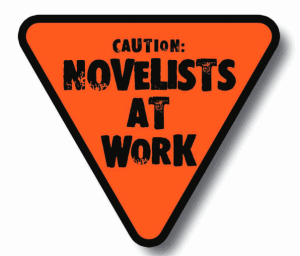 November 1st-30th–National Novel Writing Month (NaNoWriMo to those in the know)–is when the entire world picks up a pen and writes. Thousands of words a day with the goal of finishing a novel in a month. Words pour from pens like ants racing to an abandoned picnic. People stop going to movies, watching TV, skip football games, all in the name of literary endeavor.
November 1st-30th–National Novel Writing Month (NaNoWriMo to those in the know)–is when the entire world picks up a pen and writes. Thousands of words a day with the goal of finishing a novel in a month. Words pour from pens like ants racing to an abandoned picnic. People stop going to movies, watching TV, skip football games, all in the name of literary endeavor.
Last year, over 256,000 people participated. Over 36,000 of them were winners defined in the rules as writing over 50,000 words. The tagline–thirty days and nights of literary abandon–couldn’t be more true. In any month but November, a novel would take from one to ten years to complete, exhaust the writer and infuriate those close to them who don’t understand how fictitious people can be so gal-darn fascinating.
Well, for the fourth year in a row (or the fourteenth if I count from Year One), I’ll be skipping this massive meeting of the minds. I weighed the pros and cons, lined them up on two sides of an 8.5×11 sheet of college lined notepaper, compared and contrasted, and realized it just won’t work for me. Here’s why:
I don’t believe in miracles
To rephrase Ashton Kucher, NaNoWriMo looks an awful lot like work
I have to wash my hair (Is that excuse ever followed by something believable?)
To rephrase Winston Churchill, It has all the virtues I dislike (hard work, cerebral endeavor, camaraderie) and none of the vices I admire (sloth, perspicacity, wordiness)
Some books get clearer the more words you put into them; mine just gets murkier
The ribbon broke on my typewriter (does anyone know what I’m talking about?)
I have to get ready for Thanksgiving
My protagonist’s on strike
I don’t have anything to wear
I burned that bridge last year
Writing a novel in 30 days is one of the things I do best–along with finding needles in haystacks.
I asked my husband if he’d support me in my endeavor. He said, Sure, in the tone of voice he uses to tell me the toilets are backed up again.
Of course not. I don’t have to leap into a fire pit to know I’ll get burned.
I don’t usually let sleeping dogs lie, but here, I’ll make an exception
After all is said and done, a h*** of a lot more is said than done.
I can write, but it won’t do any good
If there is a God, he always takes a break November 1st – November 30th
As an efriend once commented, “Been there, done that, got the T-shirt, worn a hole in it and now use it as a duster”
I like deadlines as much as sticking my tongue on a block of ice
Ever see a car backfire? That’s my brain on NaNoWriMo
the words that would be the roar in my engine never seem to show up
NaNoWriMo doesn’t even beat hitting golf balls in sand traps
The Moving Finger writes; and, having writ, Moves on
Anyone have one good reason why I should enter? No? You at the back of the room–speak up…
–reprinted from Today’s Author.
Jacqui Murray is the author of the popular Building a Midshipman , the story of her daughter’s journey from high school to United States Naval Academy. She is webmaster for six blogs, an Amazon Vine Voice book reviewer, a columnist for Examiner.com and TeachHUB, Editorial Review Board member for Journal for Computing Teachers, Cisco guest blog, and a monthly contributor to Today’s Author. In her free time, she is editor of a K-8 technology curriculum and technology training books for how to integrate technology in education. Currently, she’s editing a thriller that should be out to publishers next summer. Contact Jacqui at her writing office or her tech lab, Ask a Tech Teacher.
Filed under: Uncategorized


November 12, 2013
How to Describe a Fight
Ever wonder how to describe the violence of a fight between two characters in your story–if you’re not a fighter? I’m not so I took note of how my favorite thriller characters did this–people like Jack Reacher. I realize it’s not so much about

Physical or verbal? This post deals with the physical.
the wham-bam as the focus, the preparation, the concentration that goes into success.
Here are some samples. As with all my descriptors, don’t use these verbatim!. They are some other author’s intellectual property. Use them for inspiration. See how others have done it so you can create your own unique path.
Hand-to-hand
And charged. He threw up his forearms like an offensive lineman blocking a defensive back, but Pike slipped to the side, pushed the man’s elbow down and away, caught his head, and rolled him into the floor. Third of a second once contact was made, and Pike was on his feet, watching the muscular man rush toward him in slow motion as the three other men, even more slowly, jumped to their feet. The muscular man reached under his shirt even as he pushed past the tables. Pike did not try to stop the gun; he rolled his hand under the man’s wrist, drove the man’s arm over and back, and pulled him backward and down. Pike had the gun before the man slammed into the floor, and hit him on the forehead with it two hard times.
He put out a nice stiff left, which he planned to follow with a right cross. I slipped to the left, which threw him off enough so that I could step inside the right cross and get a handful of his hair. I pulled his head forward and broke his nose with my head. Still holding his hair in one hand, I got my other hand into his crotch and put my shoulder into him and lifted him off the ground and slammed him down on the hood of the truck. He grunted, and went limp. When I stood back, he slowly slid off the hood and lay in the street with his mouth open
Wells tackled him, a linebacker drilling a quarterback from the blindside, a clean shoulder-to-shoulder hit that arched Marley’s spine. The gun clattered from his hand and skittered into the drainage ditch. Wells kept coming, driving his legs, finishing the hit.
He smashed an elbow into the side of Marley’s skull, the soft spot high on the temple.
Gun fights used to be all there was
Slapped his right palm down on the man’s face, shattering his nose.
Black rugby shirt swung his chain wildly now, his eyes dropping to check on his friend and then darting back up, with equal measures of fury and terror, to the bearded man in front of him.
Dewey yanked back with his right forearm, snapping the man‘s neck like a tree branch.
He expected it, anticipated it, and in the moments after landing he let his body relax.
His partner was on his hands and knees how, scrambling toward the bed. I caught him and dragged him to his feet and turned my hip as he tried to knee me in the groin. I banged his nose with my forehead and pushed him away and hit him left cross straight right and he fell over on the bed
Took another step forward, crowding him
I slapped him with my open left hand full across the face. It rocked him and he took a step back and then steadied himself, blinking his eyes and staring at me. His headache must have been a starburst.
I hit him a left hand in the V under his ribs where the sternum ends. It paralyzed his diaphragm and he gasped and doubled over and then pitched forward onto the sidewalk.
I grabbed his wrist with my left hand and held his gun hand against his chest, the gun caught under the jacket and I hit him twice more with my right, square in the nose. He sagged and I shoved him away,
Philosophy/quotes
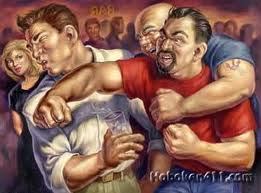
Muscle over mind
Mortal danger brings clarity
Like two scorpions in a bottle
Pain
He absorbed the trauma, swallowing the pain, then kicked his way slowly back to the surface.
Pain was just an illusory sensation that his mind could shut down if it needed to, he told himself. Put it aside.
Techniques
Paralyzes vocal cords with a strike to the neck
Box ears to break their ear drums
Banged together the heads of his two helpers. It sounded like a bat hitting a baseball.
Knives

Classic knife fight
He had a knife. I moved away from him. He was stronger than Ichabod and had a knife. He started toward me. I had my gun in an ankle holster but I didn’t want to start shooting in the middle of the street if I didn’t have to. I took another step back and slid my belt out of my pant loops. I looped it around my left hand so that the buckle end swung loose
Torture
Multiple small incisions on the thighs, all just splitting the skin. He’d then applied the salt
Guns
Bullets tore through the door, sending splinters flying.
Windows shattered, spewing glass shards everywhere
Bullets gouging the walls
Spray of bullets tore through the line of front windows, striking a side wall, shattering a beautiful gilded mirror
The man had seen Jack’s shadow, seen awhisper of movement and dove to the ground. Jack’s bullet went tinto a tree and spewed up a whirlwind of leaves
Ignoring the pain in his thigh, the blood seeping from the cut in his left arm and tried to move as quickly and quietyly as possible
How do you win a gun fight without a gun?
Shoot the smell off a skunk at a hundred yards
Some were home by now having their first drink before dinner. Maybe looking at the paper. Probably none of them were planning to shoot it out with a bunch of sociopaths.
He lunged for Pike’s gun, but Pike rolled his hands down and away with a minor wing chun deflection, and snapped the Python up hard into the bottom of the man’s chin, popping his jaw like a rat trap. The Python flicked again, and this time, Pike hit him in the Adams’ apple. The bagman clutched at his throat, choking. His face turned bright red
Opened up with sharp, recise three-round bursts, their fire guided by the infrared dots visible through their monoculars.
Carver’s reaction was subconscious, automatic. He fired at the man and the backup who came after him.
He never turned his back on a wounded man
After
Badly bruised, lacerations, and at least one of his teeth had recently been knocked out
My hands were sore. I stumbled out into the kitchen and put ice cubes in a bowl and ran some water and put my hands in to soak.
I knocked five of them out—what’s wrong with that—nothing except there were 8.
Recovery
I took a deep breath. It hurt my ribcage. I exhaled, inhaled again, inched my arms under me and pushed myself up on my hands and knees. My head swam. I felt my stomach tighten and I threw up, which hurt the ribs some more. I stayed that way for a bit, on my hands and knees with my head hanging, lik a winded horse. My eyes focused a little better. I could see the snow and the dog’s footprints. I crawled over, got hold of the park bench and slowly got myself upright. Everything blurred for a minute, then came back into focus gain. I inhaled some more and felt a little steadier.
Watch this slideshow of fights. What story do they tell?
More writing descriptors:
Jacqui Murray is the author of the popular Building a Midshipman , the story of her daughter’s journey from high school to United States Naval Academy. She is webmaster for six blogs, an Amazon Vine Voice book reviewer, a columnist for Examiner.com and TeachHUB, Editorial Review Board member for Journal for Computing Teachers, Cisco guest blog, and a monthly contributor to Today’s Author. In her free time, she is editor of a K-8 technology curriculum and technology training books for how to integrate technology in education. Currently, she’s editing a thriller that should be out to publishers next summer. Contact Jacqui at her writing office or her tech lab, Ask a Tech Teacher.
Filed under: descriptors, writers resources Tagged: characters, descriptors, fighting, writers resources, writing




